| Call Options ... which to buy ?? |
The other day I was thinking of buying a Call Option and ...
>What! You always lose money on options!
Yes ... true, but I was thinking about which I would choose ... of a jillion choices I could make.
So here's my problem:
Well, I'll look at other Days to Expiry of course and get another table like Figure 1 and ... >So what's the best choice? That, my friend, is the problem 
| 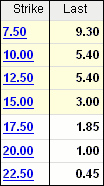 Figure 1 |
- For each choice of T = Days to Expiry and K = Strike Price I determine the annualized return necessary to make money on that particular option.
- Remember, I have the privilege of buying the stock at the Strike $K any time before Expiry, but it costs me the premium $C to buy that privilege.
- That means that, if there are T Days to Expiry and the stock is currently selling at $S then, in order to make money, the stock price has to increase to at least K + C and that's an increase of (K+S)/S in T days or an annualized return of [(K+C)/S](365/T) - 1.
|
>Your total cost is K + C?
Well ... if we ignore the commission to buy the option (which is what we'll do since that depends upon the broker). From Figure 1 we'd need the stock to increase (for each choice of option) as in Figure 2. That'd give our Breakeven stock price. >So, what's the best? Okay, for each choice of K = Strike Price we've determined our Breakeven = K + C. Now we calculate (for each K), the annualized return required to achieve that Breakeven stock price ... that's [(K+C)/S](365/T) - 1. | 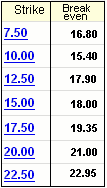 Figure 2 |
Funny you should ask. I checked around on some discussion forums and the concensus was that it's meaningless or maybe pointless or maybe misleading or maybe ...
>Yeah, yeah, I get the idea.
In any case, in Excel, this percent would be:
|
=((K+S*NORMSDIST((LN(S/K)+(Rf+V^2/2)*T/365)/(V*SQRT(T/365)))-K*EXP(-Rf*T/365)*NORMSDIST((LN(S/K)+(Rf+V^2/2)*T/365)/(V*SQRT(T/365))-V*SQRT(T/365)))/S)^(365/T)-1
where we've used the Black-Scholes premium and K = strike price S = stock price T = days to expiry V = volatility Rf = risk-free rate |
|
>What's S again?
The current stock price which, for this example, happens to be S = 15.00 so, for example, if I bought the 7.50 option I'd need the stock to increase at the annual rate of: [(K+C)/S](365/T) - 1 = [(7.50+9.30)/15](365/126) - 1 = [16.80/15](365/126) - 1 = 0.389 or 38.9% >Fat chance!
>I assume there's a spreadsheet?
>Examples?
RIGHT-click here and Save Target to download a ZIPd spreadsheet. |
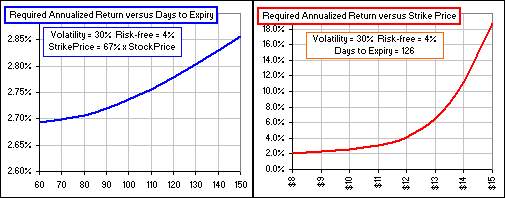 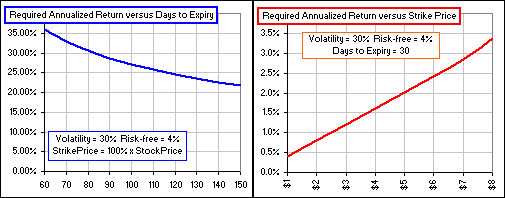 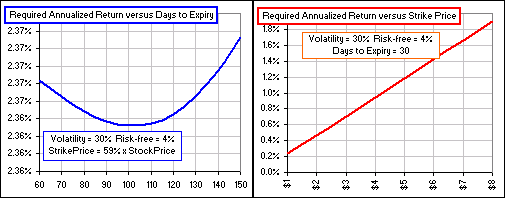
|
|
>Haven't you done this before?
Uh ... can't remember. Wait'll I check: |
|
Okay, let's consider that:


 click for part II
click for part II